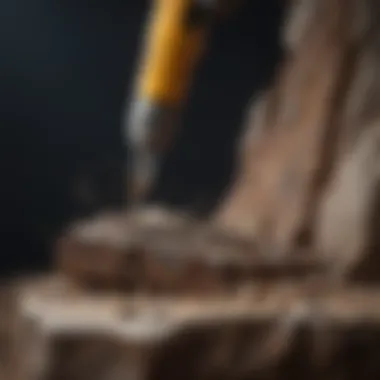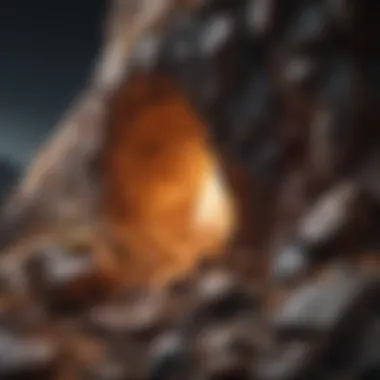Unveiling the Profound Benefits of Rock Cutting Oil in Geology


Rock and Fossil Identification
In the realm of geology, rock and fossil identification serve as fundamental pillars for understanding Earth's history and the intricate processes that have shaped our planet for millennia. Various types of rocks and fossils provide invaluable insights into the geological evolution, from sedimentary to igneous and metamorphic compositions. When embarking on the journey of identification, geologists keenly observe distinctive characteristics such as mineral composition, texture, color, and hardness to decipher the origins and history encapsulated within each specimen. Utilizing specialized tools like magnifying lenses, streak plates, and hardness picks enables meticulous examination, aiding in the precise classification of rocks and fossils.
Collecting Tips and Techniques
Efficiently collecting rocks and fossils requires a blend of strategy, patience, and expertise. Adopting best practices such as researching prime collecting sites based on geological maps and local knowledge significantly enhances the likelihood of finding unique specimens. Safety remains paramount during extraction, with techniques varying based on the fragility and location of the desired material. Proper tools such as rock hammers, chisels, and brushes are essential for carefully excavating specimens without causing damage, ensuring their integrity remains intact throughout the process.
Preservation and Display
Preserving the authenticity and longevity of collected rocks and fossils necessitates adherence to meticulous techniques to prevent degradation or deterioration over time. Implementing preservation methods like cleaning with gentle brushes and avoiding exposure to harsh environmental conditions ensures their pristine condition endures. Employing proper storage solutions such as acid-free containers and moisture-absorbent materials mitigates the risk of deterioration. Creatively displaying rocks and fossils in specialized cases or shadow boxes enhances visual appeal while simultaneously safeguarding against dust and physical harm.
Geological Insights
Delving deep into geological formations and processes unveils a captivating narrative of Earth's geological history. Examining the historical significance of rocks and fossils offers profound insights into past environments, climate changes, and biological evolution. Noteworthy discoveries in the field of geology have revolutionized our understanding of the planet, with fossils like Archaeopteryx and the Burgess Shale showcasing pivotal moments in evolutionary history. By studying geological formations and processes, we gain a deeper appreciation for the intricacies of Earth's formation and the continuous evolution that shapes our world.
Introduction to Rock Cutting Oil
Rock cutting oil has become a critical component in the world of geology, revolutionizing cutting processes and enhancing the examination of geological specimens. In this article, we delve deeply into the realm of rock cutting oil, exploring its pivotal role in optimizing cutting precision and efficiency for geological samples. By understanding the intricacies of rock cutting oil, we can unlock a closer examination of the hidden geological world within rocks.
Understanding the Basics
Composition of Rock Cutting Oil
Rock cutting oil is meticulously formulated to possess specific properties that aid in the cutting of rocks. Its composition typically includes additives such as lubricants, coolants, and anti-corrosive agents, designed to facilitate smooth cutting operations. This unique blend of components ensures a seamless cutting process, preventing heat buildup and friction, thus preserving the integrity of geological samples. The choice of composition in rock cutting oil is crucial in determining its efficacy and performance, making it a popular choice among geologists and researchers seeking precision in their cutting procedures.
Purpose and Functionality
The primary purpose of rock cutting oil is to provide lubrication and cooling during cutting processes, reducing the resistance between the cutting tool and the rock surface. This functionality is essential in enhancing cutting precision and efficiency, allowing for clean and precise cuts without causing damage to the geological specimen. By reducing heat generation and friction, rock cutting oil ensures smooth cutting motions, contributing to the overall quality of geological sample preparation.
Key Properties
Key properties of rock cutting oil include its viscosity, lubricating abilities, and heat dissipation characteristics. These properties are fundamental in determining the effectiveness of the oil in cutting applications. A balance of these key properties ensures optimal performance, enhancing the cutting process and preserving the quality of geological specimens. Understanding the key properties of rock cutting oil is crucial for choosing the right type that aligns with specific cutting requirements and geological materials.
Importance in Geology
Enhancing Precision in Cutting
Precision in cutting is paramount in geological analyses, where accuracy and detail are critical for interpreting geological formations. Rock cutting oil plays a crucial role in enhancing precision by facilitating smooth and controlled cutting motions. This precision is vital for obtaining accurate geological samples without causing unnecessary damage or alteration to the specimen's structure.
Minimizing Friction and Heat Generation


Friction and heat generated during cutting processes can adversely impact the quality of geological samples, leading to deformation or alteration. Rock cutting oil minimizes friction by providing a lubricating barrier between the cutting tool and the rock surface, reducing heat buildup. By mitigating these effects, rock cutting oil ensures that the integrity of geological specimens is maintained, allowing for precise cutting operations.
Preserving Geological Specimens
Preservation of geological specimens is crucial for further analysis and research. Rock cutting oil aids in this preservation by reducing the likelihood of damage during cutting procedures. By minimizing friction, heat, and mechanical stress, rock cutting oil helps protect the geological specimen's integrity, ensuring that the extracted samples reflect their natural composition accurately.
Applications of Rock Cutting Oil
In the world of geology, the applications of rock cutting oil are integral to the efficiency and precision of cutting processes for geological specimens. This crucial component plays a significant role in enhancing the accuracy of cuts and minimizing the risk of damage to valuable samples. By using rock cutting oil, geologists can achieve superior results in their work, allowing for a closer inspection and analysis of the intricate structures hidden within rocks.
Laboratory Settings
- Use in Thin Section Preparation
Use in Thin Section Preparation
Rock cutting oil is particularly valuable in thin section preparation, where precision is key to extracting detailed information from geological samples. The unique properties of rock cutting oil ensure smooth and precise cuts, essential for creating thin sections that are vital for microscopic analysis. This specialized use of rock cutting oil enhances the overall quality of thin sections, enabling geologists to study rocks in greater detail and uncover hidden geological features.
- Microscopic Analysis
Microscopic Analysis
When it comes to microscopic analysis, rock cutting oil provides critical lubrication and cooling properties that are essential for accurate observations. Its ability to reduce friction and heat generation ensures that the specimens remain intact and undamaged during the analysis process. This aspect of rock cutting oil is indispensable for geologists conducting microscopic investigations, facilitating a clear and detailed examination of geological samples.
Fieldwork Expeditions
- Portable Solutions
Portable Solutions
In fieldwork expeditions, the portability of rock cutting oil solutions proves to be a time-saving and convenient asset. Portable packs of rock cutting oil allow geologists to maintain cutting precision on-site, ensuring efficient sample processing in remote locations. The ease of transport and application of these solutions adds practical value to geological fieldwork, enabling researchers to collect samples effectively and maintain accuracy in cutting processes.
- Efficient Sample Collection
Efficient Sample Collection
Efficient sample collection supported by rock cutting oil streamlines the fieldwork process and optimizes resource utilization. The unique feature of using rock cutting oil for sample collection lies in its ability to preserve the integrity of samples while facilitating swift extraction. This efficiency in sample collection minimizes the risk of contamination or damage to specimens, enhancing the overall success of fieldwork expeditions.
Advantages of Using Rock Cutting Oil
Rock cutting oil provides numerous benefits in the realm of geology, elevating cutting processes to new levels of efficiency and precision. One key advantage is the improved cutting performance it offers, which is essential for obtaining accurate results in geological sample preparation. By using rock cutting oil, geologists can enhance the precision of their cutting tasks significantly, ensuring that the resulting specimens are of high quality and suitable for detailed analysis. This enhanced precision plays a crucial role in achieving better outcomes in geological research and exploration.


Improved Cutting Performance
Enhanced Precision:
Enhanced precision is a specific aspect of rock cutting oil that sets it apart in the world of geology. The ability of rock cutting oil to facilitate precise cuts on geological samples is unparalleled. This precision ensures that geologists can obtain thin sections with exceptional accuracy, revealing the intricate details within rocks that might otherwise be missed. The key characteristic of enhanced precision is its ability to maintain a consistent cutting edge, allowing for clean and sharp cuts that are vital for geological analysis. Geologists prefer rock cutting oil for its ability to deliver consistent outcomes and reduce errors in cutting procedures, making it a popular choice for enhancing cutting precision in geological applications and research.
Reduced Damage to Samples:
Another significant aspect of rock cutting oil is its capacity to reduce damage to geological samples during cutting processes. The delicate nature of many geological specimens requires careful handling to prevent any unintended alterations or deformities. Rock cutting oil helps mitigate the risk of sample damage by reducing friction and heat generation, which can impact the integrity of the specimens. The key characteristic of reduced damage to samples is its ability to provide a lubricating barrier between the cutting tool and the sample, minimizing wear and tear during cutting. Geologists appreciate this feature as it helps preserve the quality and structural integrity of the samples, ensuring that their geological findings remain accurate and reliable.
Longevity and Preservation
Extended Tool Lifespan:
One of the tangible benefits of using rock cutting oil is the extended lifespan it offers to cutting tools. The formulation of rock cutting oil not only improves cutting performance but also extends the longevity of the tools used in the process. The key characteristic of an extended tool lifespan is the reduction of wear on cutting tools, resulting in less frequent replacements and maintenance. Geologists find this aspect advantageous as it reduces operational costs and ensures continuous efficiency in cutting operations.
Maintenance of Sample Integrity:
Maintaining the integrity of geological samples is paramount in the field of geology, and rock cutting oil plays a vital role in this aspect. The unique feature of rock cutting oil lies in its ability to safeguard the structural integrity of samples during cutting procedures. By minimizing damage and ensuring smooth cutting processes, rock cutting oil helps geologists preserve the quality of their samples for thorough examination and analysis. The advantage of maintaining sample integrity is invaluable as it guarantees that research outcomes are based on intact and unaltered specimens, leading to more reliable conclusions and findings.
Environmental Impact
Eco-Friendly Formulations:
Considering the importance of environmental sustainability, the adoption of eco-friendly formulations in rock cutting oil is a significant advancement in the field of geology. Geologists value this specific aspect of rock cutting oil for its minimal environmental impact, as eco-friendly formulations reduce the release of harmful substances into the ecosystem. The key characteristic of eco-friendly formulations is their biodegradability and non-toxic nature, making them a preferred choice for environmentally conscious professionals in geology. By choosing eco-friendly rock cutting oil, geologists contribute to sustainable practices in their field while ensuring that their research activities align with environmental responsibility.
Sustainable Practices:
In line with global efforts towards sustainability, the incorporation of sustainable practices in rock cutting oil usage has become increasingly relevant in geology. The key characteristic of sustainable practices in this context is their focus on reducing waste and promoting energy-efficient solutions in cutting processes. Geologists appreciate the long-term benefits of sustainable practices as they not only support ecological balance but also lead to cost savings and operational efficiency. By adopting sustainable practices in rock cutting oil application, geologists demonstrate their commitment to environmental stewardship and contribute positively to the preservation of natural resources within their field.
Choosing the Right Rock Cutting Oil
The selection of the appropriate rock cutting oil holds paramount importance in the realm of geology. When delving into the domain of rock cutting, ensuring the right oil is utilized can significantly impact the efficiency, accuracy, and overall success of the process. By focusing on specific elements such as compatibility with materials, viscosity levels, and adherence to safety standards, geologists can optimize their cutting procedures and ensure the integrity of their geological specimens remains intact.
Factors to Consider
Compatibility with Materials
Considering the compatibility of rock cutting oil with materials is crucial to achieving effective cutting outcomes. The oil must be tailored to work harmoniously with the geological samples and cutting tools to ensure smooth operations without compromising the structure or composition of the specimens. This compatibility ensures that the oil does not react negatively with the materials, allowing for precise cuts while maintaining the authenticity and quality of the samples.
Viscosity Levels


Viscosity levels play a significant role in the efficacy of rock cutting oil. Optimal viscosity ensures proper lubrication and cooling during cutting, minimizing friction and heat generation. By selecting oils with the ideal viscosity levels, geologists can enhance the precision of their cuts, prevent damage to samples, and prolong the lifespan of their cutting tools. Maintaining the right viscosity also contributes to the overall efficiency of the cutting process, enabling geologists to work with ease and accuracy.
Safety Standards
Adhering to stringent safety standards is non-negotiable when choosing rock cutting oil. Prioritizing oils that meet specified safety regulations guarantees a secure working environment for geologists and minimizes potential risks associated with the cutting process. Oils compliant with safety standards not only ensure the protection of personnel but also safeguard the geological specimens from any adverse effects that substandard oils might cause. By prioritizing safety, geologists can conduct their cutting operations confidently and with peace of mind.
Best Practices in Rock Cutting
In the realm of geology, mastering the best practices in rock cutting is paramount to unlocking the hidden treasures within geological specimens with precision and care. Understanding and implementing these practices not only ensure efficient cutting processes but also contribute to the preservation of valuable samples for further analysis and research purposes. The significance of best practices lies in their ability to enhance accuracy, minimize damage to specimens, and maintain the integrity of geological findings. By adhering to established guidelines and utilizing proper techniques, geologists and researchers can elevate their cutting procedures to a higher standard, amplifying the quality of their scientific endeavors.
Proper Usage Techniques
Cutting Procedures:
Within the context of rock cutting oil usage, cutting procedures play a pivotal role in determining the outcome of the cutting process. These procedures encompass a series of steps and methods employed to slice through geological samples efficiently and effectively. The key characteristic of cutting procedures lies in their ability to provide a systematic approach to transforming raw rock samples into manageable pieces for further analysis. This systematic approach ensures precision cutting, minimizes the risk of damage to samples, and facilitates the extraction of insightful data from the specimens. Its significance in this article stems from its contribution to streamlining the cutting process, optimizing sample preparation, and accelerating research efforts.
Maintenance Tips:
Maintenance tips in rock cutting serve as a crucial aspect of ensuring the longevity and performance of cutting tools and equipment. These tips encompass a set of guidelines and practices aimed at preserving the quality and functionality of cutting instruments, such as saws, blades, and drills. The key characteristic of maintenance tips lies in their ability to prolong the lifespan of tools, prevent premature wear and tear, and uphold cutting precision throughout extended usage. Incorporating proper maintenance techniques not only safeguards the investment in equipment but also sustains the efficiency of cutting processes, ultimately contributing to successful geological investigations. In this article, maintenance tips are highlighted for their role in promoting sustainable practices, reducing operational costs, and maintaining consistent cutting performance.
Safety Precautions
Protective Gear:
The use of protective gear is essential in rock cutting scenarios to ensure the safety and well-being of individuals engaging in cutting activities. Protective gear comprises various equipment and attire designed to shield users from potential hazards, such as flying debris, sharp edges, and exposure to harmful substances. The key characteristic of protective gear lies in its ability to provide physical protection, enhance user comfort, and minimize the risk of injuries during cutting operations. Incorporating appropriate protective gear is a non-negotiable aspect of ensuring a secure working environment, reducing accidents, and fostering a culture of safety awareness in geological settings. This article underscores the importance of protective gear for its pivotal role in safeguarding personnel, mitigating risks, and promoting responsible cutting practices.
Storage Recommendations:
Proper storage recommendations are vital for maintaining the quality and integrity of both rock cutting oil and associated equipment used in geological cutting processes. These recommendations entail guidelines and practices for storing oils, tools, and samples in a controlled environment to prevent degradation, contamination, or loss of efficacy. The key characteristic of storage recommendations lies in their ability to prolong the shelf life of oils, preserve the functionality of tools, and ensure the stability of geological samples for future analyses. Adhering to suitable storage practices not only safeguards the efficiency of cutting operations but also enhances the overall effectiveness of geology research endeavors. This article emphasizes the significance of accurate storage methods for their role in promoting sustainability, reducing wastage, and maintaining optimal cutting conditions.
Future Trends and Innovations
In the realm of geology, staying abreast of future trends and innovations is paramount to advancing the field's cutting-edge practices. Future trends not only shape the methodologies used in geological processes but also pave the way for enhanced precision and efficiency. Embracing innovation is key to unlocking new possibilities and maximizing the potential of rock cutting oil in geological studies. By delving into upcoming advancements, geologists can harness the power of technology to revolutionize their approaches and achieve unprecedented insights.
Technological Advancements
Automation in Cutting Processes
Automation in cutting processes represents a revolutionary leap in the world of geology. This advanced technology streamlines cutting procedures, significantly improving efficiency and precision. Its key characteristic lies in its ability to execute repetitive tasks with utmost accuracy, eliminating human error and enhancing the overall quality of geological specimen preparation. Automation in cutting processes is a popular choice for geologists aiming to expedite sample processing without compromising on accuracy.
Moreover, the unique feature of automation lies in its seamless integration with digital systems, enabling geologists to achieve unparalleled consistency in cutting operations. While automation streamlines processes and boosts productivity, it also reduces the risk of sample contamination and ensures uniformity in cutting results. With these advantages, automation in cutting processes emerges as a game-changer in the utilization of rock cutting oil, offering geologists a reliable and efficient solution for their precision cutting needs.
Smart Lubrication Systems
Smart lubrication systems represent another groundbreaking innovation enhancing the application of rock cutting oil in geology. These systems are characterized by their intelligent monitoring capabilities, which optimize lubrication levels based on real-time data feedback. By automatically adjusting lubricant flow and distribution, smart lubrication systems ensure optimal performance and longevity of cutting tools.
The key advantage of smart lubrication systems is their ability to reduce wastage and minimize environmental impact through precise lubricant application. Geologists benefit from consistent lubrication levels, which in turn enhances cutting efficiency and prolongs tool lifespan. However, as with any technology, smart lubrication systems may have their disadvantages, such as initial setup costs and potential technical complexities. Nevertheless, the overall benefits they offer in terms of sustainable lubrication practices and enhanced cutting performance make them a valuable asset in the toolkit of modern geologists.







